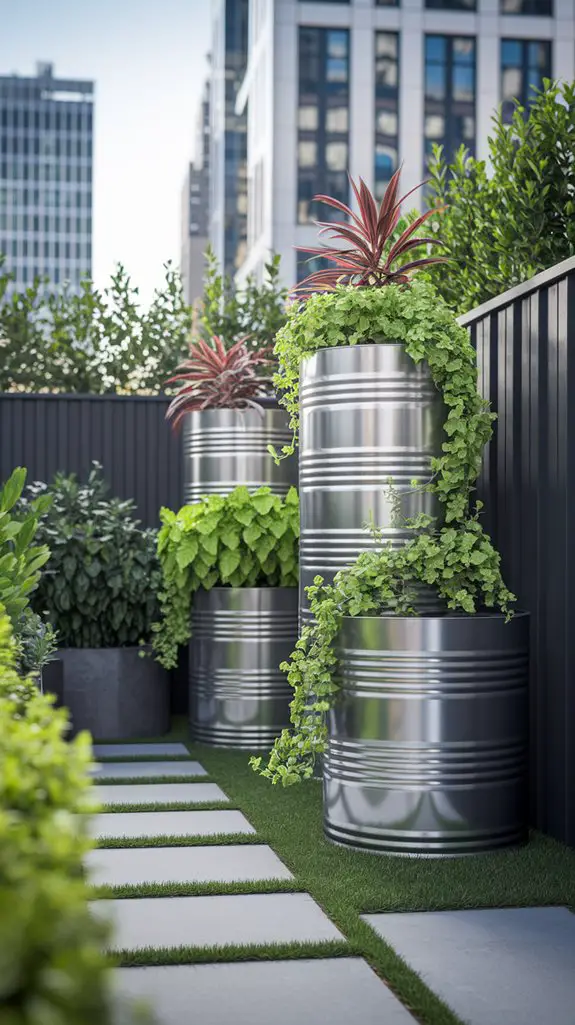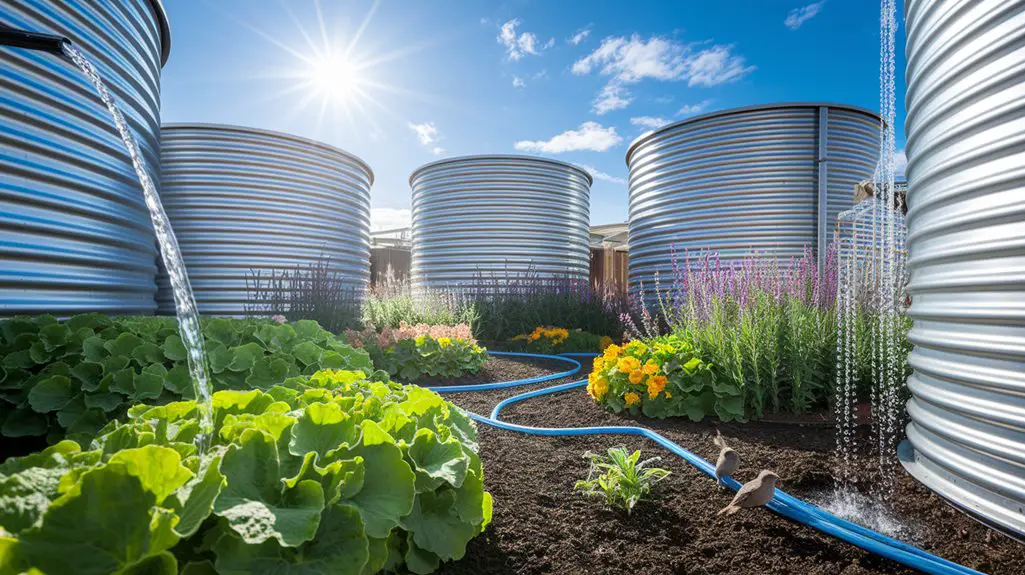Imagine rainfall cascading off your rooftop, each precious drop waiting to nourish your urban garden. You’ve likely noticed rising water bills and increasingly unpredictable weather patterns affecting your growing space. Rainwater harvesting offers a practical solution that combines ecological responsibility with gardening efficiency. By capturing nature’s free resource, you’ll reduce municipal water consumption while providing plants with chemical-free hydration. The systems can be surprisingly simple to implement, but require thoughtful design for maximum effectiveness.
The Benefits of Capturing Urban Rainfall
While water scarcity affects growing urban populations, capturing rainwater offers an elegant solution with multiple benefits.
You’ll reduce your water bill while creating resilience against drought conditions and municipal restrictions. A typical roof can collect 600 gallons from just one inch of rainfall.
Harvested rainwater is ideal for gardens as it’s naturally soft, chlorine-free, and pH-balanced. Your plants will thrive with this chemical-free alternative to treated tap water.
Additionally, you’ll mitigate stormwater runoff, reducing erosion and pollution in local waterways. Furthermore, implementing sustainable rainwater harvesting techniques can enhance the ecological benefits of your landscape.
Essential Components for Your Rainwater Collection System

A functional rainwater harvesting system requires several key components working together to efficiently collect, filter, and store precipitation.
Start with quality gutters and downspouts that direct water from your roof to the collection point. Install a first-flush diverter to eliminate initial runoff containing contaminants.
Your storage tank—whether barrel, cistern, or underground container—should be UV-resistant and food-grade if you’ll use water for edibles.
Size it according to your local rainfall patterns and garden needs. Include an overflow mechanism for heavy rain events.
Don’t forget filtration: mesh screens prevent debris entry, while finer filters remove smaller particulates.
A distribution system—whether gravity-fed or pump-assisted—delivers water to your plants.
Finally, install a secure lid to prevent mosquito breeding and contamination. Additionally, consider incorporating innovative rainwater systems that enhance efficiency and sustainability in your garden.
Space-Efficient Storage Solutions for Limited Urban Areas

Urban dwellers face unique spatial constraints when implementing rainwater collection systems. You’ll need strategic solutions to maximize water storage in minimal space.
Consider slim-profile vertical tanks that attach to walls or fences, utilizing height rather than footprint. Modular systems allow for expansion as needed, with interconnected smaller units that fit awkward spaces.
Underground cisterns installed beneath patios or garden beds provide substantial capacity without consuming visible areas. For balconies or tiny yards, collapsible containers offer flexibility, expanding when filled and compressing when empty.
Dual-purpose furniture like bench-tanks or planter-reservoirs integrate storage seamlessly into your living space. Rain pillows—flat, flexible containers—can slide under decks or in crawl spaces, storing significant volumes in otherwise unusable areas. Rainwater collection barrels are a practical option for those looking to enhance their systems further.
Choose UV-resistant, food-grade materials to guarantee water quality and system longevity.
Maintaining Water Quality in Harvested Rainwater
Ensuring your harvested rainwater remains clean and safe requires proactive management throughout the collection process.
First, install leaf guards and first-flush diverters to prevent debris and initial contaminants from entering your storage system. These simple devices redirect the first few gallons of rainfall, which typically contain the highest concentration of pollutants.
Monitor pH levels regularly, aiming for 6.0-8.0 for ideal plant health.
Consider installing UV filters or food-grade hydrogen peroxide (3%) at 1-2 tablespoons per 50 gallons if algae becomes problematic. For edible plants, additional filtration through activated carbon or ceramic filters removes microscopic contaminants.
Clean collection surfaces quarterly and storage tanks annually to prevent biofilm development.
Cover tanks to block sunlight and use mosquito dunks containing Bacillus thuringiensis for insect control without compromising water safety. Additionally, regularly reviewing sustainable outdoor water features can provide insights into improving your rainwater collection and management practices.
Connecting Your Harvesting System to Urban Garden Irrigation
Connecting your rainwater harvesting system to irrigation networks maximizes collection efficiency while reducing municipal water dependency. You’ll need pressure-compensating options that work with gravity-fed systems or supplemental pumps for larger gardens. Consider automatic distribution controls that respond to soil moisture sensors for ideal water usage.
- Use food-grade piping with UV-resistant properties for above-ground installations
- Install Y-filters at connection points to prevent debris clogging in drip emitters
- Incorporate backflow preventers where harvested water systems interface with municipal supplies
- Select pressure-regulating valves calibrated to 15-30 PSI for efficient drip irrigation
- Implement zone-specific timers to deliver precise water quantities based on plant requirements
For small spaces, simple gravity-fed drip systems work effectively, while larger urban gardens benefit from automated controllers with weather-responsive features. Additionally, rainwater harvesting systems can significantly reduce water bills, making them a cost-effective solution for urban gardening.
Creative DIY Rainwater Harvesting Projects for City Dwellers
Consider installing downspout diverters that channel water into compact barrel systems tucked against walls. Balcony-dwellers can attach slim rain chains leading to vertical storage containers. Repurpose everyday items for cost-effective solutions: convert old food-grade buckets into cascading collection systems or transform plastic storage totes into sub-irrigation planters that directly water container gardens. Wall-mounted collection panels can double as decorative elements while funneling water to strategically placed reservoirs. For microapartments, collapsible water bladders store flat when empty but expand during rainfall events. Install fine-mesh filters at collection points to prevent debris accumulation and mosquito breeding—essential for maintaining water quality in dense urban settings. Additionally, utilizing rainwater harvesting systems can significantly enhance your garden’s sustainability and resilience against drought.
Conclusion
You’re now equipped to transform your urban oasis into a water-efficient ecosystem. By implementing these harvesting techniques, you’ll slash your water bills while your garden drinks from the sky’s bounty. Remember, every drop counts in our increasingly parched urban landscapes. Maintain your system diligently, and you’ll create a sustainable cycle that benefits both your plants and our planet’s precious water resources.



